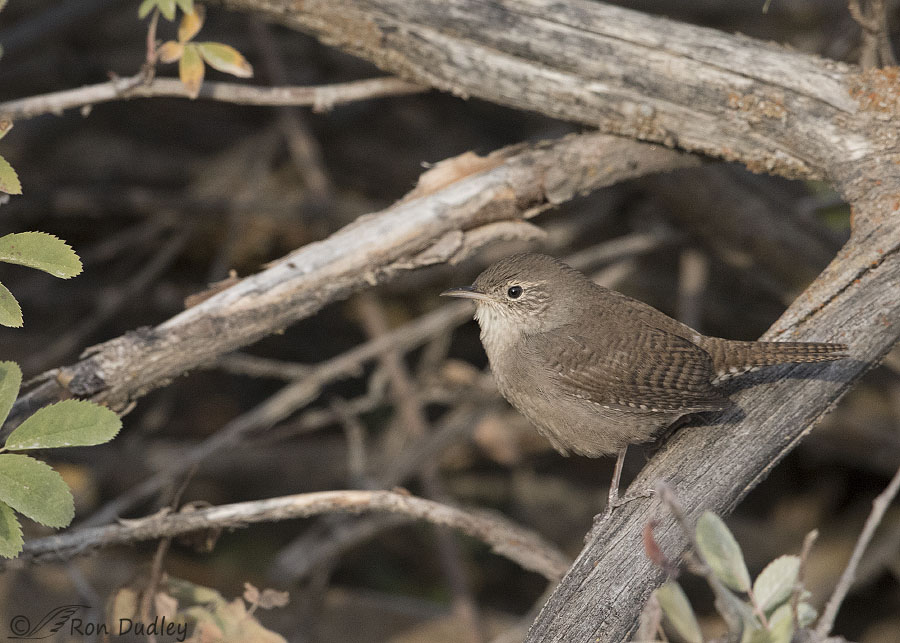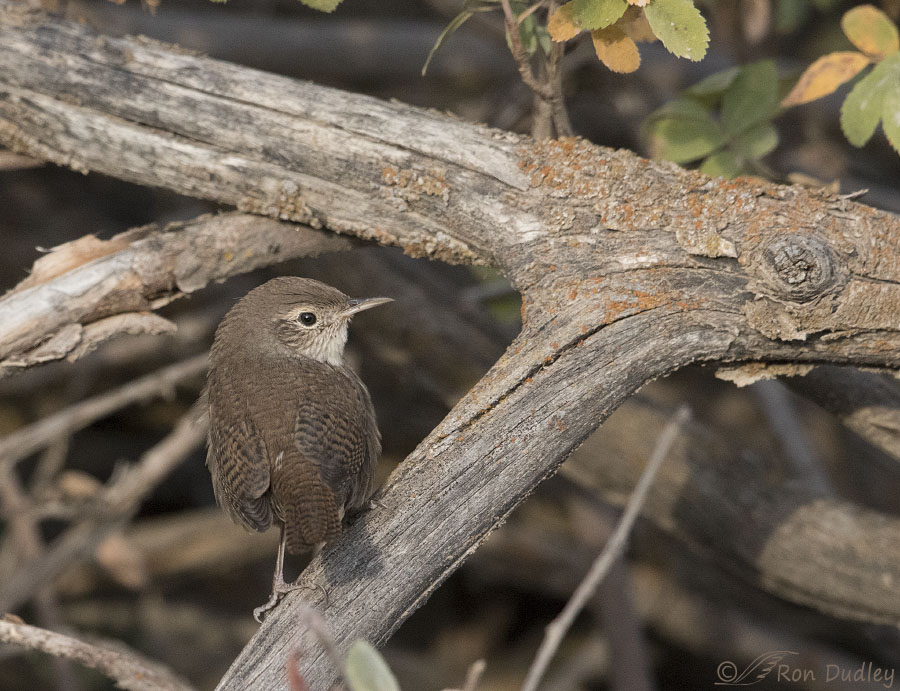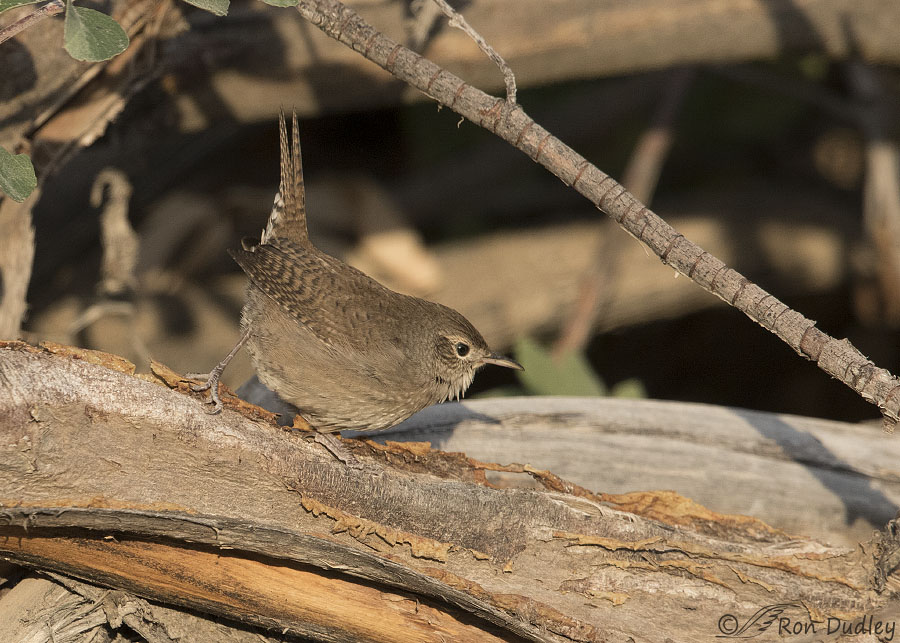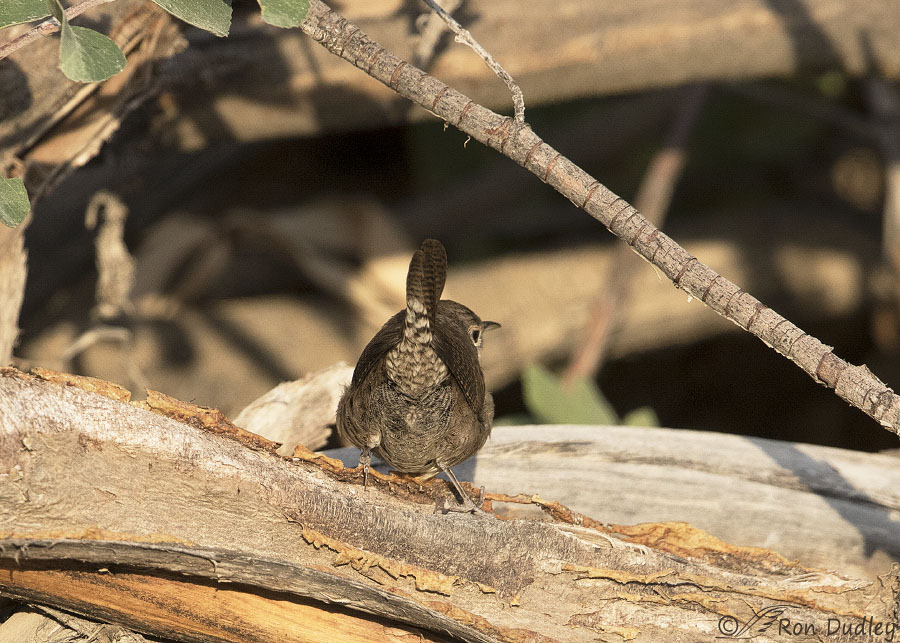House Wrens have more significance and impact on the worldwide avian scene than most folks realize.

1/1600, f/6.3, ISO 1600, Canon 7D Mark II, Canon EF 500mm f/4L IS II USM + EF 1.4 III Extender, not baited, set up or called in
I photographed these two wrens four days ago in the Wasatch Mountains. It was cloudy when I took these first two shots of one of them so I really cranked up my ISO to get some reasonable shutter speed.
From what I hear from blog readers and others I get the impression that in many other parts of the country these birds are almost ubiquitous in some suburbs, especially back east – being easily attracted to nest boxes and extremely tolerant of human activity. But that’s far from my experience with them out west. I never see them in the city or suburbs, only in forests and wooded canyons where they generally seem to be quite shy, although they’re less reclusive when nesting.
This wren was scrounging around a woodpile as it hunted for insects and small spiders.

1/1600, f/6.3, ISO 1600, Canon 7D Mark II, Canon EF 500mm f/4L IS II USM + EF 1.4 III Extender, not baited, set up or called in
I kind of like this butt-shot with the bird looking toward the lichens on the dead stump (I do wish the lichens were a bit sharper).

1/1600, f/6.3, ISO 800, Canon 7D Mark II, Canon EF 500mm f/4L IS II USM + EF 1.4 III Extender, not baited, set up or called in
The sun came out for these last two shots of presumably another bird. What I notice about this photo is the way the wren has angled its body to mimic the angle of the smaller diagonal branch at upper right. In composition little things matter, whether they work for you or not. It’s often a matter of taste.
House Wrens are holders of two notable records involving avian populations and our knowledge of birds.
- No other bird species in the Western Hemisphere occupies a broader latitudinal range than the House Wren. They occupy territory and breed from Canada all the way down to the southernmost part of South America and even the West Indies.
- Humans know more about the biology of the House Wren, including their “genetics, immunology, energetics and physiology, ecology, demography, reproductive and other behavior, sex allocation, communication, systematics, and more,” than any other wild bird species in the world! Since science is currently revising the number of estimated bird species on the planet from 9000 -10,000 species to somewhere closer to 18,000 species (see this link from the American Museum of Natural History if you’re skeptical of that claim), to my mind that’s a very impressive statistic.
But I like House Wrens for more reasons than just statistics. I adore their saucy personalities – they’re brassy, they’re sassy and…

1/1600, f/6.3, ISO 800, Canon 7D Mark II, Canon EF 500mm f/4L IS II USM + EF 1.4 III Extender, not baited, set up or called in
they’re endlessly cheeky.
Ron
Note: If you’re wondering what evidence there might be to back up the claim that we know more about House Wrens than any other bird species in the world I offer the following from Cornell’s Birds of North America Online:
- “As of the mid-2010s, more than 700 research papers, government reports, theses and dissertations had been published that touched on one or more aspects of House Wren biology.”


Wren butts! That last shot is terrific!
Heh heh …this was a great start to my morning. Go wrens!
Giggle-snort on the last shot. Stay classy, little wren!
Fascinating information combined with enchanting shots.
Giggle-snort appreciated, Marty.
I am a huge fan of the small birds which punch well above their weight. Sass and charm.
That’s a very good description of a House Wren, EC.
Very entertaining sequence. This bird appears to be sizing you up and telling you where you can place your photographic equipment.
Ha, the way my back feels right now my “photographic equipment” just might have ended up there, Lyle!
Bahahahah on that last one. It would make a great MEME (no, I wouldn’t do that!)
What you have heard and know about this rascal in the East is true. Not shy at all, will try and prevent other bird box birds nesting if they want the box and will sing over your head if you are quiet and alone. Your images are great, but I have to admit House Wrens are not my favorite when I’m trying to attract Bluebirds and Tree Swallows. I have to admit that the problems have been minimal here, we are too open for them. Pictures #1 and #2 are my favorites. Thanks for sharing.
I’ve seen the same wren behavior you mention many times, Dick but it’s always been at a natural nest cavity in a tree in the forest. Often they’ve been fighting with Tree Swallows.
Just love these little guys and I miss them in my new environment. I have a soft spot in my heart for cheeky! I’m so easily amused And add lichen into the shot and you’ve got me hook, line and sinker.
And add lichen into the shot and you’ve got me hook, line and sinker.
In the third shot, I wonder what’s got that bird’s chin feathers sticking out? Any idea?
It’s heartening to hear about so much research on wrens, but I’d like to see more research into redtail hawks! Just me and I AM biased.
I noticed those chin feathers too, Laura. I don’t know what was going on.
They are cheeky little things, aren’t they? I once had one build a nest in a wreath on my front door. All of these shots show tons of personality. I love them all.
They sure are, Robyn. Thanks.
Hello, Ron. I enjoy your postings and shared enthusiasm for birds. Today’s, and many others, especially enjoyable for the observations of behavior and habitat. We have had nesting House wrens for several years. We also have a growing population of house sparrows and Eurasian tree sparrows. In the one experience where at winter’s end I “helped” the wren by cleaning its preferred nesting gourd–that protruding too-long twig tossed without thought. The House wren had to fight for its gourd that Spring. I haven’t messed with their protruding twig since. It serves a purpose, maybe two. Just another observation. Thank you for your wonderful forum!
Jennie Townsend, O’Fallon, MO
Fascinating observation, Jennifer – it was new to me.
I love Wrens of any sort. Not sure I’ve ever seen a House Wren, but am very familiar with Carolina Wrens (who have the same kind of personality as House Wrens) and the several species we have here. My favorite of those is the Canyon Wren, which as a beautiful cascading song. As with all Wrens, they have a loud voice for such a small bird, and they use the rock formations at the park to magnify their voice. Wrens always make me smile, especially “cheeky” shots like the last one.
I share your fondness for all wrens, Susan. If I had to choose a favorite to photograph it just might be the Marsh Wren but if it were to listen to it would be the Canyon Wren, hands down. To hear that descending cascade echoing off of canyon walls is a spine-tingling experience for me.
I absolutely agree with the song of the Canyon wren! Followed closely by the white-crowned sparrow, the canyon wren’s song is so beautiful that it will break your heart!
Awesome photos of a very cute bird. I especially love the last butt shot! Always enjoy seeing these birds and the listening to the pleasant racket they make when scolding folks or critters who enter their territory. thanks for sharing!
Thank you, Joanne.
Pretty birds and much information that I was not aware of. I have only gotten photos of House Wrens a couple times here. Now House Finches – everywhere. I think I like one and three best. With bird photography it often takes a hundred or so photos to get 3 or 4 really good ones. Now if they would only sit still for a couple minutes. I was just thinking yesterday when I was out that the two birds here that are the easiest to photograph are Phainopeplas and Blue Grosbeaks. Both are relatively unafraid and will generally pose for you for for a good period of time.
Everett Sanborn, Prescott AZ
Phainopeplas and Blue Grosbeaks would both be lifers for me, Everett. Envy…
I LOVE House Wrens! Except when they are trying to build a nest above a rolled up outside shade!
Except when they are trying to build a nest above a rolled up outside shade!  Large sticks used for such a small bird and they are persistent! Here human activity doesn’t seem to bother them much tho they will chatter/dive at humans (and anything else) that gets too close to their nests. Wonderful shots, Ron.
Large sticks used for such a small bird and they are persistent! Here human activity doesn’t seem to bother them much tho they will chatter/dive at humans (and anything else) that gets too close to their nests. Wonderful shots, Ron. 
“Large sticks used for such a small bird and they are persistent”
Exactly, Judy. It’s hilarious to watch them try to get a twig that’s too long into their nest hole in a tree.
Great series of photos…also information I did not know. I can’t choose a favorite photo of this set…perhaps #1 &2 because they show the ‘stripping’ of brown and black so well. Then of course #3&4 shows their attitude! This has been an elusive bird for me to capture. I get glimpses of them in the wild but not long enough to zero in. A work in progress for me. Course it took me dozens of hours to get great pictures of the marsh wren and then one day…a few hundred photos. Hope springs eternal for the bird photographer!
“it took me dozens of hours to get great pictures of the marsh wren and then one day…a few hundred photos”
I’ve had the same experience many times with a variety of species, Kathy – most recently with Yellow Warblers.